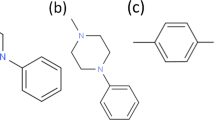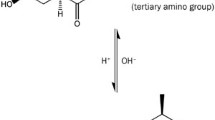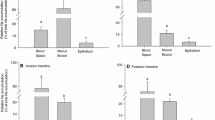Abstract
This study has been undertaken to investigate the mechanisms of intestinal mucosal transport and metabolism of thymidine analogues and to identify any optimal site(s) of the rat intestine particularly involved in the absorption of thymidine analogues. The intestinal absorption of 3′-azido-3′-deoxythymidine (AZT) was studied at three initial concentrations in four segments of the rat intestine using an in situ recirculating perfusion technique. Disappearance of AZT followed first-order kinetics throughout the gastrointestinal (GI) tract at all tested concentrations. The apparent first-order rate constants were found to be relatively invariant over a broad range of concentrations from 0.01 to 1.0 mM. Corrected for the length of each segment, the apparent permeability (P app) of AZT was 3.01 ± 0.32 × 10−5 cm/sec (mean ± SE) in the duodenum, 2.06 ± 0.24 × 10−5 cm/sec in the upper jejunum, 0.76 0.13 × 10−5 cm/sec in the combined lower jejunum and ileum, and 0.32 ± 0.10 × 10−5 cm/sec in the colon, which indicated that intrinsic absorptivity was greater in the upper GI tract than in the lower portions possibly due to the differences in surface area for absorption. No AZT metabolite appeared in any part of the GI tract. On the other hand, thymidine and other analogues, i.e., 5-iodo-2′-deoxyuridine and 2′-deoxyuridine, were rapidly metabolized into nucleobase and sugar in the upper GI tract, whereas in the colon no metabolite appeared. A free 3′-OH group appears to be necessary for the metabolism (catabolism) of thymidine analogues in the rat intestine mainly by pyrimidine nu-cleoside phosphorylase. Finally, bile salt-acylcarnitine mixed micelles appeared to be an effective adjuvant in promoting colonic absorptions of AZT and phenol red. The use of mixed micelles increased the apparent permeabilities of AZT in the colon by a factor of 5.4, and for phenol red the permeability increased from a negligible value to 1.76 × 10−5 cm/sec. Since the absorptions of both AZT and phenol red were enhanced by mixed micelles, a paracel-lular transport pathway may be involved.
Similar content being viewed by others
REFERENCES
M. A. Fischl, D. D. Richman, J. H. Grieco, M. S. Gottlieb, P. A. Volberding, O. L. Laskin, J. M. Leedom, J. E. Groopman, D. Mildvan, R. T. Schooley, G. G. Jackson, D. T. Durack, and D. King. The efficacy of azidothymidine (AZT) in the treatment of patients with AIDS and AIDS-related complex. N. Engl. J. Med. 317:185–191 (1987).
J. M. Collins and J. D. Unadkat. Clinical pharmacokinetics of zidovudine: An overview of current data. Clin. Pharmacokin. 17:1–9 (1989).
G. D. Morse, J. L. Lechner, J. A. Santora, and S. L. Rozek. Zidovudine upadate: 1990. Drug Int. Clin. Pharm. 24:754–760 (1990).
T. Seki, T. Kawaguchi, and K. Juni. Enhanced delivery of zidovudine through rat and human skin via ester prodrugs. Pharm. Res. 7:948–952 (1990).
R. Yarchoan, R. W. Klecker, K. J. Weinhold, P. D. Markham, H. K. Lyerly, D. T. Durack, E. Gelmann, S. N. Lehrman, R. M. Blum, D. W. Barry, G. M. Shearer, M. A. Fishl, H. Mitsuta, R. C. Gallo, J. M. Collins, D. P. Bolognesi, C. E. Myers, and S. Broder. Administration of 3′azido-3′-deoxythymidine, an inhibitor of HTLV-III/LAV replication, to patients with AIDS or AIDS-related complex. Lancet 1:575–580 (1986).
R. W. Klecker, J. M. Collins, R. Yarchoan, R. Thomas, J. F. Jenkins, S. Broder, and C. E. Myers. Plasma and cerebrospinal fluid pharmacokinetics of 3′-azido-3′-deoxythymidine: A novel pyrimidine analog with potential application for the treatment of patients with AIDS and related diseases. Clin. Pharmacol. Ther. 41:407–412 (1987).
M. R. Blum, S. H. T. Lioa, S. S. Good, and P. Demiranda. Pharmacokinetics and bioavailability of zidovudine in humans. Am. J. Med. 85 (Suppl. 2A):189–194 (1988).
R. Yarchoan, H. Mitsuya, C. E. Myers, and S. Broder. Clinical pharmacology of 3′-azido-2′3′-dideoxythymidine (zidovudine) and related dideoxynucleosides. N. Engl. J. Med. 321:726–738 (1989).
D. C. Taylor and R. Grundy. Propranolol absorption in different regions of the rat gastrointestinal tract in situ: Implications for sustained release formulations. J. Pharm. Pharmacol. 32:499–500 (1980).
D. C. Taylor. Sites and mechanisms of intestinal drug absorption. Pharm. Int. 6:179–183 (1986).
H. E. Kaufman. Clinical cure of herpes simplex keratitis by 5-iodo-2′-deoxyuridine. Proc. Soc. Exp. Biol. Med. 109:251–252 (1962).
W. D. Ensminger and E. Frei. The prevention of methotrexate toxicity by thymidine infusions in humans. Cancer Res. 37:1857–1863 (1977).
D. S. Zaharko, B. J. Bolten, D. Chiuten, and P. H. Wiernik. Pharmacokinetic studies during phase I trials of high-dose thymidine infusions. Cancer Res. 39:4777–4781 (1979).
W. W. Oppelt, D. R. Clarkson, and S. L. Melvin. Metabolism of 5-iodo-2′-deoxyuridine (IUdR) in brain and liver of dogs. Res. Commun. Chem. Pathol. Pharmacol. 2:553–566 (1971).
J. A. Fix, K. Engle, P. A. Porter, P. S. Leppert, S. J. Selk, C. R. Gardner, and J. Alexander. Acylcarnitines: Drug absorption-enhancing agents in the gastrointestinal tract. Am. J. Physiol. 251:G332–G340 (1986).
J. L. Richardson, P. S. Minhas, N. W. Thomas, and L. Illum. Vaginal administration of gentamicin to rats. Pharmaceutical and morphological studies using absorption enhancers. Int. J. Pharm. 56:29–35 (1989).
D. T. O'Hagan, H. Critchley, N. F. Farraj, A. N. Fisher, B. R. Johansen, S. S. Davis, and L. Illum. Nasal absorption enhancers for biosynthetic human growth hormone in rats. Pharm. Res. 7:772–776 (1990).
N. F. Farraj, S. S. Davis, G. D. Parr, and H. N. E. Stevens. Absorption of progabide from aqueous solutions in a modified recirculating rat intestinal perfusion system. Int. J. Pharm. 43:93–100 (1988).
L. S. Schanker, D. J. Tocco, B. B. Brodie, and C. A. M. Hogben. Absorption of drugs from the rat small intestine. J. Pharmacol. Exp. Ther. 123:81–88 (1958).
M. A. Hedaya and R. J. Sawchuk. Sensitive liquid-chromatographic method for determination of 3′-azido-3′-deoxythymidine (AZT) in plasma and urine. Clin. Chem. 34:1565–1568 (1988).
R. Hebel and M. W. Stromberg. Digestive system. In Anatomy of the Laboratory Rat, Williams and Wilkins, Baltimore, 1976, pp. 43–54.
K. E. Carra and P. G. Toner. Morphology of the intestinal mucosa. In T. Z. Csaky (ed.), Pharmacology of the Intestinal Permeation I, Springer-Verlag, Berlin, 1984, Chap. 1.
J. W. L. Robinson, H. Menge, F. V. Sepulveda, and V. Mirkovitch. Functional and structural characteristics of the jejunum and ileum in the dog and the rat. Digestion 15:188 (1977).
M. J. Jackson. Drug transport across gastrointestinal epithelia. In L. R. Johnson (ed.), Physiology of the Gastrointestinal Tract, 2nd ed., Raven Press, New York, 1987, pp. 1597–1621.
L. Luciano, E. Reale, G. Rechkemmer, and W. VonEngelhardt. Structure of zonula occludentes and the permeability of the epithelium to short-chain fatty acids in the proximal and the distal colon of guinea pig. J. Membr. Biol. 82:145–156 (1984).
M. Tomita, M. Shiga, M. Hayashi, and S. Awazu. Enhancement of colonic drug absorption by the paracellular permeation route. Pharm. Res. 5:341–346 (1988).
Author information
Authors and Affiliations
Rights and permissions
About this article
Cite this article
Park, GB., Mitra, A.K. Mechanism and Site Dependency of Intestinal Mucosal Transport and Metabolism of Thymidine Analogues. Pharm Res 9, 326–331 (1992). https://doi.org/10.1023/A:1015882617066
Issue Date:
DOI: https://doi.org/10.1023/A:1015882617066




